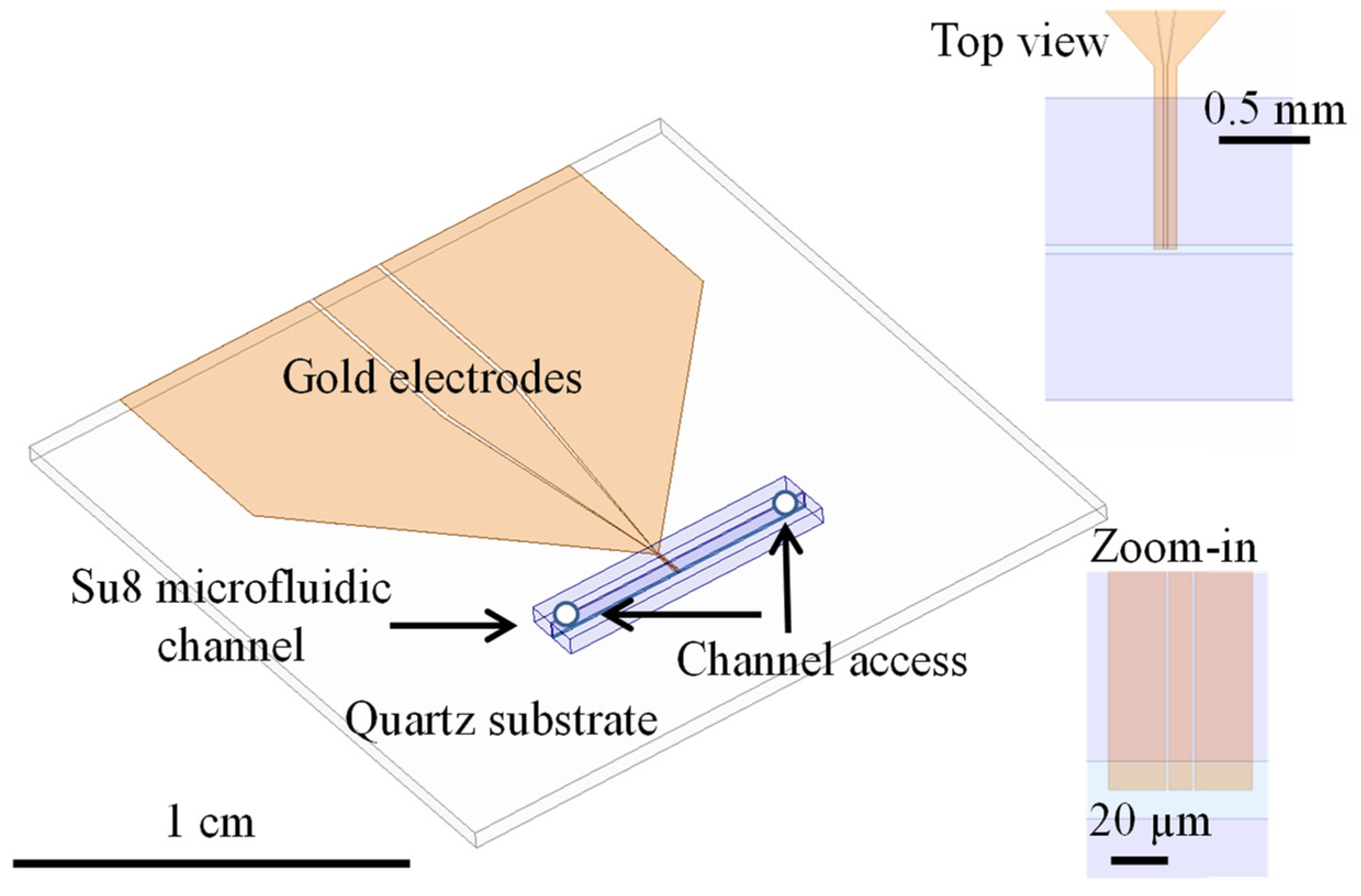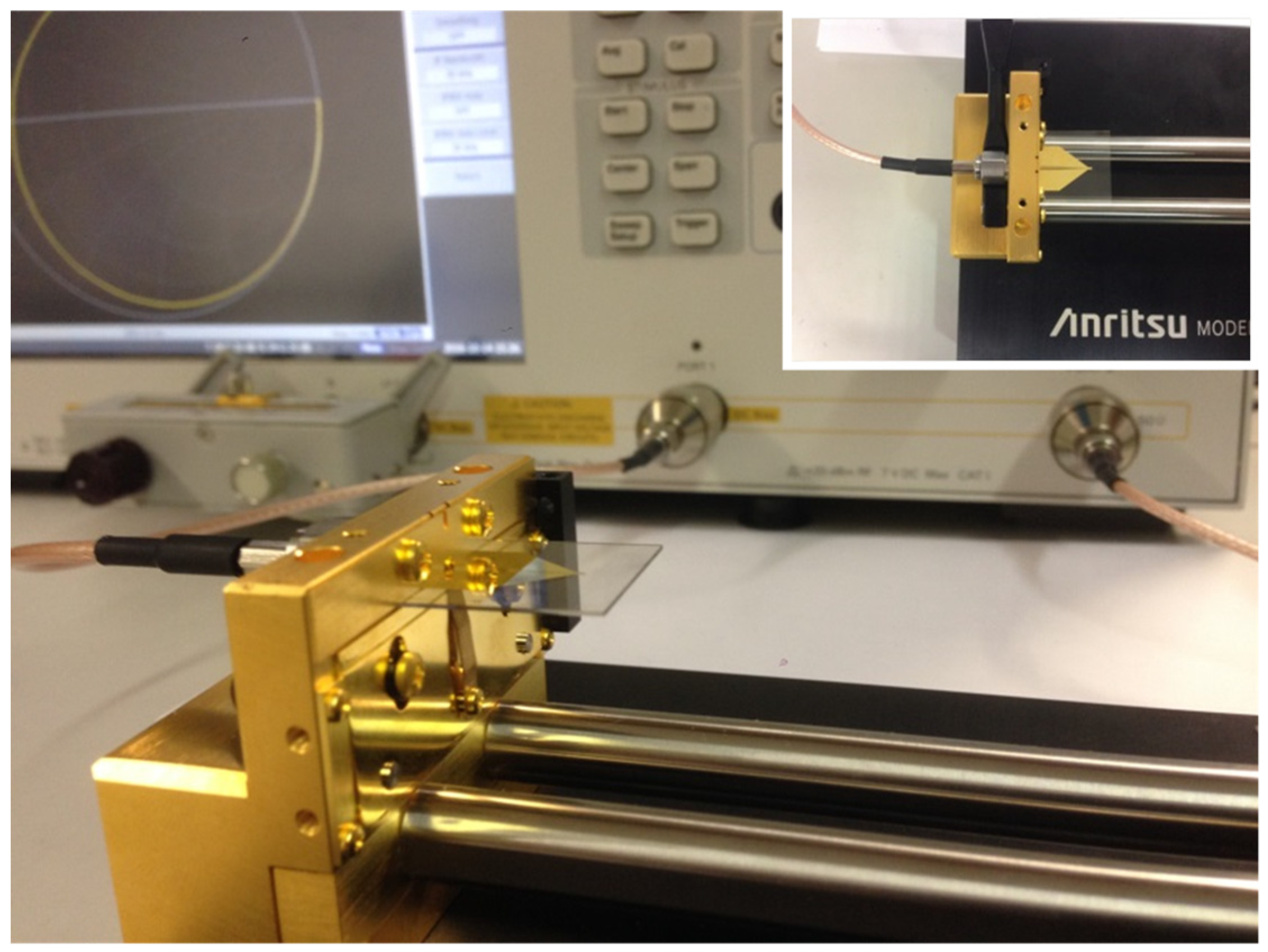Microwave Sensor within a Microfluidic Chip for Biological Applications †
Abstract
:1. Introduction
2. Set-Up Description
3. RF Measurements
4. Conclusions
Acknowledgments
Conflicts of Interest
References
- Prodan, C.; Prodan, E. The dielectric behavior of living cell suspensions. Phys. D Appl. Phys. 1999, 32, 335–343. [Google Scholar] [CrossRef]
- Mateu, J.; Orloff, N.; Rinehart, M.; Booth, J.C. Broadband Permittivity of Liquids Extracted from Transmission Line Measurements of Microfluidic Channels. In Proceedings of the 2007 IEEE MTT-S International Microwave Symposium Digest, Honolulu, HI, USA, 3–8 June 2007; pp. 523–526. [Google Scholar]
- Gabriel, S.; Lau, R.W.; Gabriel, C. The dielectric properties of biological tissues: Measurements in the frequency range 10 Hz to 20 GHz. Phys. Med. Biol. 1996, 41, 2251–2269. [Google Scholar] [CrossRef] [PubMed]
- Stuchly, M.A.; Kraszewski, A.; Stuchly, S.S.; Smith, A.M. Dielectric properties of animal tissues in vivo at radio and microwave frequencies: Comparison between species. Phys. Med. Biol. 1982, 27, 927–936. [Google Scholar] [CrossRef] [PubMed]
- Khan, U.; Al-Moayed, N.; Nguyen, N.; Obol, M.; Korolev, K.; Afsar, M.; Naber, S. High frequency dielectric characteristics of tumorous and non-tumorous breast tissues. In Proceedings of the 2007 IEEE MTT-S International Microwave Symposium Digest, Honolulu, HI, USA, 3–8 June 2007; pp. 1341–1344. [Google Scholar]
- Seo, S.; Stintzing, T.; Block, I.; Pavlidis, D.; Rieke, M.; Layer, P.G. High frequency wideband permittivity measurements of biological substances using coplanar waveguides and application to cell suspensions. In Proceedings of the 2008 IEEE MTT-S International Microwave Symposium Digest, Atlanta, Georgia, 15–20 June 2008; pp. 915–918. [Google Scholar]
- El Fellahi, A.; Bore, T.; Bensalem, S.; Bodenes, P.; Lopes, F.; Martincic, E.; Le Pioufle, B.; Francais, O. Monitoring of Microalgae Lipid Accumulation using RF Open Ended Biosensor. IEEE Sens. Lett. 2017, 1, 4500303. [Google Scholar] [CrossRef]
- Stuchly, S.S.; Bassey, C.E. Microwave coplanar sensors for dielectric measurements. Meas. Sci. Technol. 1998, 9, 1324–1329. [Google Scholar] [CrossRef]
- Seo, S.; Stintzing, T.; Block, I.; Pavlidis, D.; Rieke, M.; Layer, P.G. High frequency wideband permittivity measurements of biological substances using coplanar waveguides and application to cell suspensions. In Proceedings of the 2008 IEEE MTT-S International Microwave Symposium Digest, Atlanta, GA, USA, 15–20 June 2008; pp. 915–918. [Google Scholar]
- Grenier, K.; Dubuc, D.; Poleni, P.E.; Kumemura, M.; Toshiyoshi, H.; Fujii, T.; Fujita, H. New broadband and contact less RF/microfluidic sensor dedicated to bioengineering. In Proceedings of the 2008 IEEE MTT-S International Microwave Symposium Digest, Boston, MA, USA, 7–12 June 2009. [Google Scholar]
- Chen, T.; Dubuc, D.; Poupot, M.; Fournie, J.J.; Grenier, K. Accurate Nanoliter Liquid Characterization Up to 40 GHz for Biomedical Applications: Toward Noninvasive Living Cells Monitoring. IEEE Trans. Microw. Theory Tech. 2012, 60, 4171–4177. [Google Scholar] [CrossRef]
- Wagner, N.; Schwing, M.; Scheuermann, A. Numerical 3D FEM and experimental analysis of the open-ended coaxial line technique for microwave dielectric spectroscopy on soil. IEEE Trans. Geosci. Remote Sens. 2013, 52, 880–893. [Google Scholar] [CrossRef]
- Bore, T.; Yermán, L.; Serna, M.L.; Wall, H.; Torero, J.L.; Scheuerman, A. Dielectric spectroscopy of artificial faeces for smouldering applications. In Proceedings of the 2016 IEEE Sensors Applications Symposium (SAS), Catania, Italy, 20–22 April 2016; pp. 1–6.
- Bore, T.; Wagner, N.; Cai, C.; Scheuermann, A. Broadband electromagnetic analysis of compacted kaolin. Meas. Sci. Technol. 2016, 28, 014016. [Google Scholar] [CrossRef]
- Petong, P.; Pottel, R.; Kaatze, U. Water-Ethanol Mixtures at Different Compositions and Temperatures. A Dieletric Relaxation Study. J. Phys. Chem. A 2000, 104, 7420–7428. [Google Scholar] [CrossRef]
- Sato, T.; Buchner, R. Dielectric Relaxation Processes in Ethanol/Water Mixtures. J. Phys. Chem. A 2004, 108, 5007–5015. [Google Scholar] [CrossRef]



Publisher’s Note: MDPI stays neutral with regard to jurisdictional claims in published maps and institutional affiliations. |
© 2017 by the authors. Licensee MDPI, Basel, Switzerland. This article is an open access article distributed under the terms and conditions of the Creative Commons Attribution (CC BY) license (https://creativecommons.org/licenses/by/4.0/).
Share and Cite
Fellahi, A.E.; Bore, T.; Rousseau, L.; Pioufle, B.L.; Français, O. Microwave Sensor within a Microfluidic Chip for Biological Applications. Proceedings 2017, 1, 523. https://doi.org/10.3390/proceedings1040523
Fellahi AE, Bore T, Rousseau L, Pioufle BL, Français O. Microwave Sensor within a Microfluidic Chip for Biological Applications. Proceedings. 2017; 1(4):523. https://doi.org/10.3390/proceedings1040523
Chicago/Turabian StyleFellahi, Abdellatif El, Thierry Bore, Lionel Rousseau, Bruno Le Pioufle, and Olivier Français. 2017. "Microwave Sensor within a Microfluidic Chip for Biological Applications" Proceedings 1, no. 4: 523. https://doi.org/10.3390/proceedings1040523




